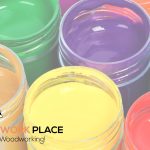Both polyurethane and polycrylic are urethane-based sealants, and they’re fantastic at safeguarding wood from water-damage and scratches.
Widely used to seal everything from cabinets to chairs, there are few easily accessible finishes that are as simple to apply as these two sealers.
Now, we know they work great on wood. However, do they work equally as well when applied over vinyl decal covered wooden surfaces too?
And if they do, which one will do a better job at sealing Cricut vinyl decals on wood?
Well, in this post you will learn what the difference is between polycrylic and polyurethane. You will also find out what a ‘bonding primer’ is — and why it matters when it comes to applying poly sealers over vinyl stickers.
And keep reading to discover which one of these two sealers is better at protecting Cricut vinyl decals on wood.

This post may contain affiliate links to products that we receive a commission for (at no additional cost to you). Learn more here.
Are Polycrylic And Polyurethane Pretty Much The Same Thing?
They are similar in that they are both urethane-based wood sealers. However, the balance of ingredients in them differ.
Specifically, Polycrylic is an acrylic and urethane blended sealer.
Another big difference between them is that polyurethane can be either oil-based or water-based. You can even get polyurethanes that are a modified blend of the two.
On the other hand, Polycrylic is a water-based sealer by Minwax.
And Can Either Polyurethane Or Polycrylic Seal Over Cricut Vinyl Decals On Wood?
If you apply them directly onto that smooth vinyl surface, then probably not.
You see, vinyl decals can be applied over polyurethane, because they can stick to smooth surfaces with ease.
Related Post: Will Vinyl Stick To Polyurethane? (A Quick Guide To Perfect Adhesion)
But if you were to attempt the reverse (poly over vinyl) you may run into adhesion issues.
That’s because both polyurethane and polycrylic will peel off if they’re directly applied onto very smooth surfaces.
This is why we often need to prep a wooden surface, (before we apply poly finishes), by sanding it.
Why Do You Need To Sand Before Applying Polycrylic Or Polyurethane?
Lightly sanding any smooth surface will roughen it up a little. This provides poly finishes with a bit of grip for it to adhere to as it dries and cures.
This is the main reason why you should always sand in between multiple coats of polyurethane or polycrylic.
So, if you want to apply either polyurethane or polycrylic directly onto vinyl, you’ll have problems with adhesion.
How Do You Get Poly Finishes To Stick To Smooth Vinyl Decal Covered Surfaces?
If you want to seal vinyl with either one of these two urethane-based sealers, you have two options:
1). Sand The Vinyl Decal
It goes without saying, that this is not an ideal solution.
Sure, it will work. But it will be at the cost of your beautiful Cricut vinyl decal designs.
2). Use A Spray-On Bonding Primer
A bonding primer is a quick and easy way to get two incompatible finishes/sealants to work together.
Related Post: 7 Clever Cricut Maker Wood Projects
Wait A Second…What Is A Bonding Primer Again?
Bonding primers are simply binding agents. They act like a sort of glue in between the base coat (vinyl decal) and the top coat (polyurethane/polycrylic).
Now, when it comes to woodworking, one of the easiest-to-use bonding primers you can use is Dewaxed shellac.
Dewaxed shellac is a naturally-sourced, yet incredibly sticky, wood finish. It’s a glossy finish too, so it won’t dull the shininess of vinyl decals.
This particular type of shellac finish sticks to most anything. And most things (including polyurethane and polycrylic) will stick to Dewaxed shellac in return.
On top of that, this wood finish is incredibly easy to apply very thinly. But that’s only if you use a Spray-On Dewaxed shellac (rather than a brush-on shellac).
And a thin application of this finish is exactly what you need. Why? Well, because you only need it to act as a binding agent. You aren’t using it as a complete top coating sealer.
Related Post: Can You Put Shellac Over That Off-Gassing Polyurethane?
So, a single thin coat of Spray-on Dewaxed shellac will create a sticky enough surface for poly finishes.
And once done, you can apply a Spray-on Polyurethane or Spray-on Polycrylic, over it.
Now, for best results, there are two key things that are worth emphasizing here:
1). Stick to using Spray-on Finishes/Sealers
If you want to apply thin coats of shellac or poly, use the Spray-can versions of these finishes.
Spray-on application not only saves time, it also reduces the chances of air bubbles appearing in these finishes.
Related Post: Help! Why Are There Air Bubbles In My Polycrylic Finish! [+ What You Can Do To Fix It]
2). Stick to using Dewaxed Shellac
Not all shellac finishes are equally suitable as bonding primers.
Waxed shellac sits at the opposite end of the stickiness spectrum, compared to Dewaxed shellac.
Whilst anything will stick to Dewaxed shellac, next to nothing will adhere to a waxed shellac.
But Do You Really Need To Seal Permanent Vinyl?
If you’ve applied it onto a wooden surface, then yes.
Without a protective seal, the vinyl decal can become scratched very easily. And humidity can effect both the vinyl decals adhesion to wood, as well as the wood itself.
Got It. So What Is Better? Polyurethane Or Polycrylic?
Well, the choice really boils down to aesthetics.
Polycrylic is a water-based sealer. So it doesn’t yellow over time and it dries fast.
But if you use a water-based polyurethane sealer, there’s little difference in performance between water-based polyurethane and polycrylic.
However, if you were to use an oil-based polyurethane, this polyurethane is a little more heat resistant than polycrylic.
What’s more, oil-based polyurethanes can yellow over time (a consequence of the solvents added to this sealant). And oil-based polyurethanes take much longer to dry too.
So, if you have a need for speed and want to avoid yellowing: Use either Polycrylic or Water-Based Polyurethane.
But, if you want a slightly more durable sealer: Use Oil-Based Polyurethane.
Does Polycrylic Turn Yellow? Yellowing over time is a feature of poly finishes that are oil-based. However, Polycrylic is a water-based sealant, and it doesn’t yellow with age.
To Wrap Up, Here Are The 3 Key Takeaways From This Post…
- 1). Polycrylic is a water-based sealer. It doesn’t turn yellow with age and dries very quickly.
- 2). Both Polyurethane and Polycrylic will eventually peel off Vinyl Decal if you do not apply a bonding primer between them.
- 3). Use Dewaxed shellac as a bonding primer, if you want to apply polyurethane or polycrylic (over permanent vinyl) onto wood.

![What Type Of Wood Can A Cricut Maker Cut? [A Quick Guide] what wood can cricut maker cut](https://www.thewoodworkplace.com/wp-content/uploads/2021/11/What-Type-Of-Wood-Can-A-Cricut-Maker-Cut-128-150x150.jpg)

